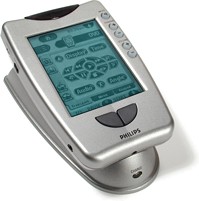|
|
 |
|

The following page was printed from RemoteCentral.com:
| User reviews for the Philips Pronto TSU2000 from Philips Electronics. |
 | | Ratings | Reviews | MSRP (USD) |
Average: 3.88/5.00
Median: 4.33/5.00 | 52 | $399 |
Based on one of the most popular LCD remote controls in the marketplace, the TSU2000 doubles the amount of memory over the TS-1000 and includes a huge new built-in library of infrared codes.
Get it
at: |  |
|
|
| Written by Greg Ewan from Tampa. The reviewer has used this remote control for 3-6 months. |
| Review 23 made on Friday August 24, 2001 at 2:51 PM. |
| Strengths: |
| Weaknesses: |
 |
| Review: | The best feature of the Pronto TSU2000 is the flexibility and the massive amount of programming that can be done on it. When I first got the pronto, I spent about 100 hours creating a raw configuration that was functional, just not where I wanted it to be. Another 100 hours later, it does everything I ever dreamed for in a reasonably-priced remote. My ccf file is one of the larger ones I’ve seen out there and I still have 45% more free memory. Practically every button throughout the programming is somehow associated with a macro because I tried to cover all of the variables that someone may encounter when they were using the pronto. I also wrote several pages of help menus in case someone got stuck somewhere while using it.
Originally I was impressed with the macro and device pull down menus but then after using it that way it was just as confusing for me and other users as picking up the 14 remote controls that were on the coffee table originally. To eliminate this problem, I streamlined the system and removed the device menus and created everything on the front page- cable, dvd, vcr, amp, phone, tv, etc. Next, all of the screens that you enter have a “back button” that will return you to the screen you were on last. My configuration tricks you into thinking that the remote’s program is simple, yet is has over 230 screens but you think you only see about 15 of them. If you take a look at my ccf that’s posted out there under complete ccf files, you’ll get the idea.
Touch the panel, then touch one button to turn the whole system on. (This triggers almost 20 IR commands but they are masked behind the illusion that you only touched 1 button.) Once that’s done, you select the component that you want then more macros start and bring you to all the correct settings on all of the components. I even built in “full house automatic” buttons that adjust everything in the house with one button. There is a button for a party setting, mood music, and others. Most of the 50 commands are volume-reset commands. In other words the volume down IR pulses out several times to lower it to the lowest notch then I counted how many times I needed to press volume up to achieve the level of sound that was comfortable for the type of music that was selected. Then I added sound field variables for the amp, subwoofer adjustments and lighting adjustments through X10 around the house. Now it’s almost like magic, touch a single button and the whole house comes alive with sound and light in every room. When you are done, touch the “all off” and everything goes dark and silent.
Yeah, I’m impressed with Philips!
|
 |
Quality:      | Features:      | Value:      |
|
|
|
|
|

